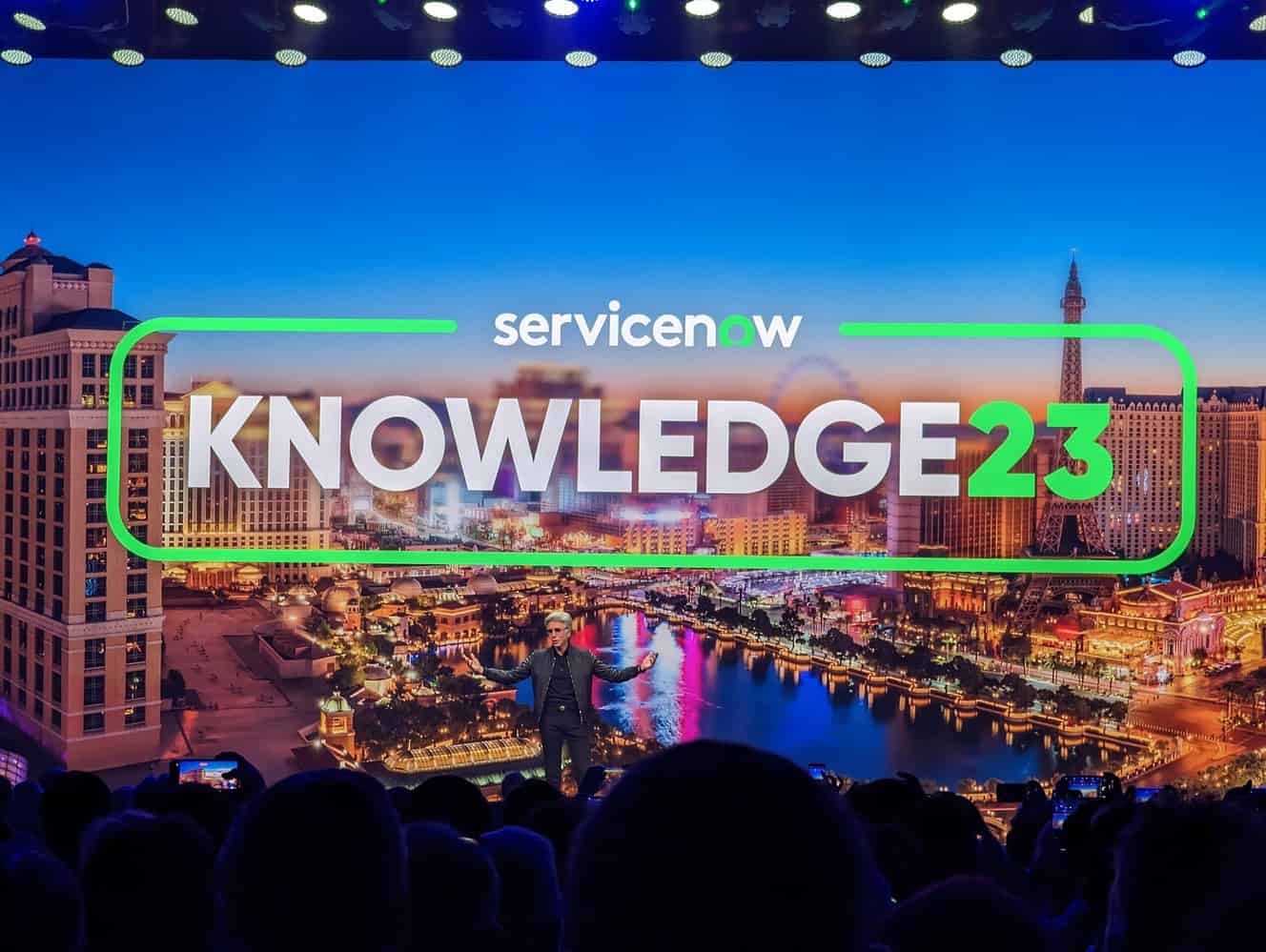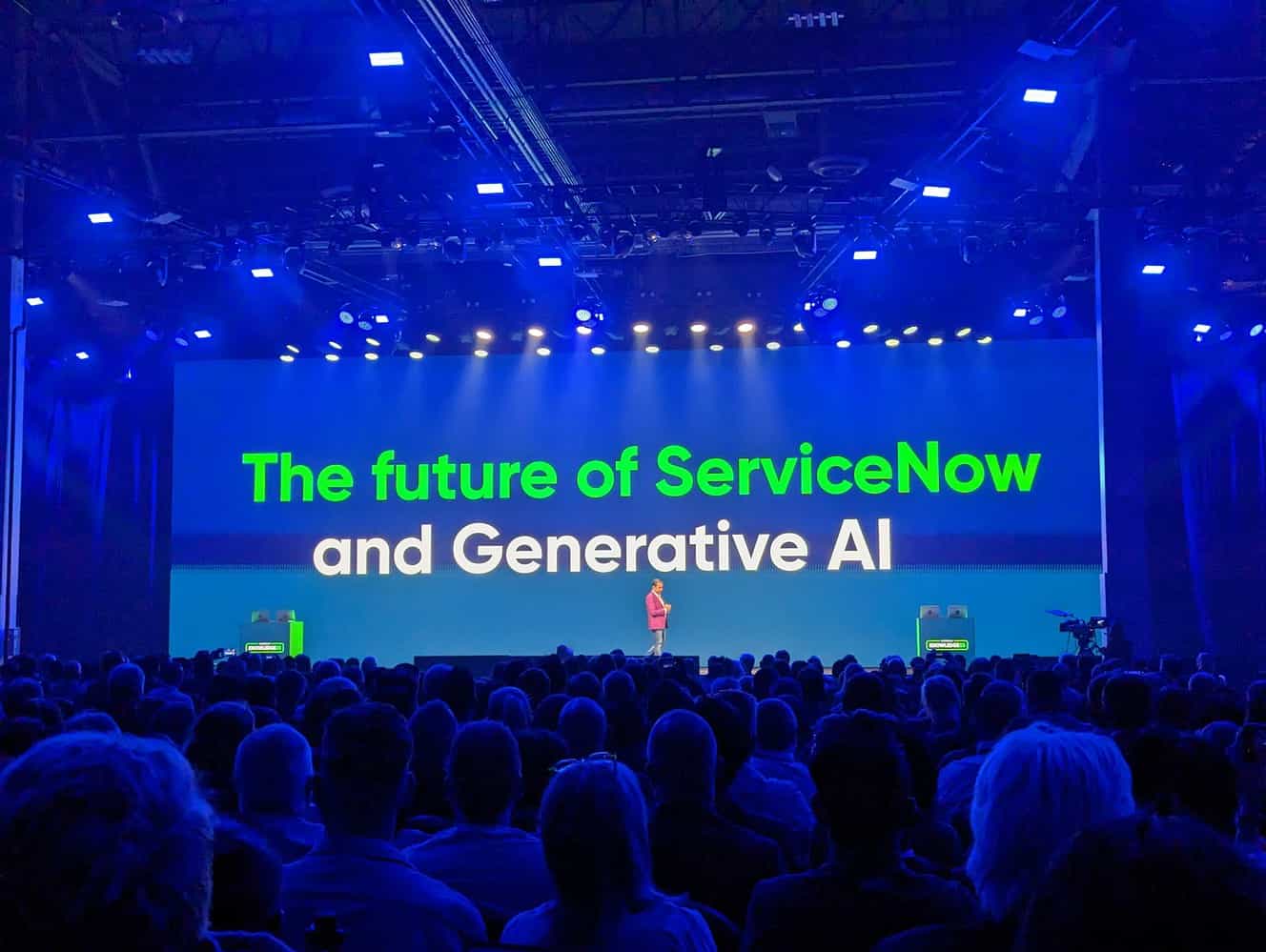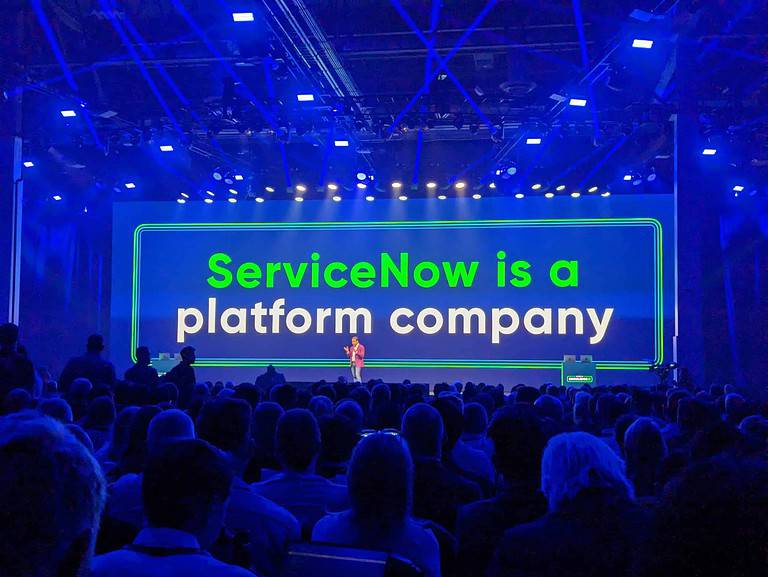This year ServiceNow hosted another global Knowledge event, the last one was four years ago. A lot has changed since 2019, for example, the company is now four times bigger and has twice as many products. Also, Bill McDermott is now at the helm as CEO, which provides new momentum and possibly even additional growth.
In 2019, we wrote the article “Nobody knows what ServiceNow does and what you can do with it.” That was our conclusion after a week-long Knowledge19. At the time, we needed about 3,500 words to explain what the company offers and how its solutions work. This already made it a lot clearer to IT decision-makers and IT professionals whether ServiceNow is a suitable solution for their organization.
So at Knowledge23, we were very curious to see if the messaging, communication and explanations are clearer today so that people better understand what ServiceNow is and does. The answer to that question came right at the first interaction with McDermott; in a pre-briefing, he revealed that the first question most CIOs ask him is, “What does ServiceNow actually do?” Most executives are told by their IT teams to talk to ServiceNow.
“What does ServiceNow actually do?”
What makes ServiceNow so complicated?
So the short answer to the question is no. However, this does not mean ServiceNow is doing poorly; the company is growing like crazy and revenue is going up by billions a year. Meanwhile, 85% of the Fortune 500 are ServiceNow customers and the company has a 90% retention rate in retaining customers.
So even though ServiceNow serves 85% of the Fortune 500, as well as many organizations below that, by no means everyone is familiar with the company. At least not exactly what it does and offers. With that comes the larger question of why that is.
Naturally, McDermott had to answer this question as well. He states that while ServiceNow’s roots are in IT, that’s not what it’s about anymore. ServiceNow is also prominent in HR, as of now integrating ERP systems and other system of records, more on that later. Generative AI will soon be added, bringing the company back to the IT a bit, McDermott said.

It’s not the most satisfying answer, not even one we agree with, because in our view, IT is the most significant force behind ServiceNow and that’s not going to change anytime soon. Probably ServiceNow is struggling to put its finger on the problem. Ultimately, it has everything to do with the story you tell or try to tell. At ServiceNow, they always want to present things bigger, better and over the top. This makes it hard for the target audience to follow. Nothing wrong with a bit of ambition and a dot on the horizon, but sometimes you just have to keep things a little simple and smaller to inform your (potential) customers.
What is not discussed by ServiceNow, but which is also a cause, is that some people know ServiceNow only subconsciously. Unlike other enterprise software, it does not push its own branding into the customer’s platform. ServiceNow offers the ability to completely restyle its platform and even customize the logos and ServiceNow branding to make it look like an organisations own platform. As a result, people using ServiceNow do not know they are using the NOW platform. Other companies often still leave a logo, a url or a notification at the bottom of the page; with ServiceNow, everything is customizable or removable.
ServiceNow’s ambition
ServiceNow’s ambition shows that the company thinks, acts and communicates at a big scale. As a result, they make things overly complex. For example, McDermott says, “I came in to this company with a dream; ServiceNow will become the defining software company of the 21st century.”
“ServiceNow will become the defining software company of the 21st century.”
His ambition cannot be more clear. In any case, the ambition does not lie. Statements like this do very well in the United States; in Europe people tend to think; just act normal and you’ll be crazy enough. In our opinion, the conversation is a bit too much about ambition and too little about what ServiceNow is doing. We don’t expect this to change any time soon; that’s just how ServiceNow is, so the discussion about what exactly ServiceNow is doing may be eternal. In addition, ServiceNow is not sitting still and continues to add solutions and capabilities to the platform. It’s up to us to keep making sense of it.
ServiceNow in a nutshell
Even though our previous analysis is four years old, it still explains a lot about the platform to get a broad picture of exactly what ServiceNow does. In a nutshell, ServiceNow is a web-based platform that consists of several great solutions around IT and HR.
These include IT Service Management, IT Asset Management, IT Operational Management, Security Operations, Governance Risk and Compliance and many others. In the area of HR, think of a complete HR Management solution that includes HR Service Delivery, Workspace Service Delivery and Employee Center.
All of those solutions underlie what ServiceNow really does at the end of the day. Provide a fully customizable portal where you can easily access information. It lets you build workflows and applications to optimize business processes in a no-code or low-code manner. It allows you to automate, improve, and make common workflows and scenarios more efficient. You can even tie together different applications outside of ServiceNow with those workflows but present the results and overview within ServiceNow. Most organizations also build vast numbers of applications on top of the platform because then they have all their data within the platform.
The solutions that the NOW platform offers by default are also fully customizable, mainly with no-code, but for the experts, also via low-code. The complete styling and construction of applications can be customized to suit your organization better. For example, Disney has given ServiceNow’s HR module a completely different look, it looks nowhere near the original. This is possible through the front-end framework developed by ServiceNow itself.
Learn more? Read this article.
What are ServiceNow’s key innovations?
A few key announcements were made at Knowledge23, which ServiceNow will use to further expand its platform that are very important to (potential) customers.
Workflows for Finance and Supply Chain
For years, ServiceNow has offered the ability to build workflows around IT processes and HR processes. The goal here is to improve the customer experience or automate business processes. At Knowledge, ServiceNow announced that the capabilities to build workflows will be expanded, specifically for Finance and Supply Chain solutions. To do this, ServiceNow uses AI, machine learning, RPA and process mining to unlock and automate familiar system-of-records solutions through workflows. This means organisations can further automate procurement, ERP, financial, and supply chain solutions.
Also read: ServiceNow Utah focuses on process mining and workforce optimization
One of the examples cited by ServiceNow itself is managing suppliers. Creating a supplier in a procurement system is often a cumbersome process, with many e-mail exchanges, requiring all kinds of forms to be filled out and shared. It is often a lot of manual work in which many labour hours are lost. With the techniques mentioned earlier, ServiceNow can provide a simpler alternative to this. It is able to scan POs, invoices and vendor registration documents and unlock the key information in these documents and automatically feed it to the system of records applications you use as an organization. The high percentage of manual work makes it an ideal process to automate with workflows. By providing support for familiar ERP, supply chain and procurement solutions, many organizations will quickly become more efficient in signing up suppliers.

ServiceNow bets heavily on generative AI
ServiceNow also cannot ignore the introduction of generative AI, such as ChatGPT from OpenAI. The NOW platform will provide support for various generative AI solutions. Through interfacing with Microsoft Azure, you can start using Microsoft’s generative AI within the NOW platform. OpenAI’s APIs will also be supported. According to ServiceNow, support for Google’s generative AI is a matter of time. However, ServiceNow does state that it only provides the linkage to these solutions; ultimately, customers themselves must enter an agreement with the providers of these generative AI solutions. Customers should also arrange governance and compliance with those providers themselves.
However, the fact is that these more generic generative AI solutions are not going to make the difference in an enterprise IT solution. It is much more effective if you use large language models (LLMs) explicitly trained for the NOW platform and more specifically for your industry or organization. ServiceNow is aware of this and is therefore investing heavily in building its own LLMs. It is even going to help customers build their own LLMs.
ServiceNow is currently working on several LLMs that will significantly enhance the NOW platform. For example, LLMs can make suggestions based on knowledge base articles to initiate workflows from a chatbot interface. It is also working on an LLM aimed at developers to help them write code faster for applications on the NOW platform.
Finally, ServiceNow is working on several LLMs to provide additional assistance within the platform. So that users can quickly build forms or modify designs through a chat interface.
To develop these LLMs, it is working with the organization Hugging Face, a specialist in AI. Hugging Face works with LLMs based on open source resources and technology. Working with Hugging Face has compliance and governance benefits that some ServiceNow customers face. Namely, you can verify the open source models and check how it came to a result, or check whether specific data is in the model. With the models from Microsoft, Google and OpenAI, this is impossible. In addition, in many cases, those models also use user input to improve their model further. Samsung has already experienced the nasty consequences of this when there were suddenly trade secrets in the OpenAI model. That can be prevented with an LLM from Hugging Face.
In addition, ServiceNow also allows customers to develop their own LLM and add it to the ServiceNow platform.
Also read: ServiceNow and Hugging Face release new LLM for code generation
ServiceNow.org brings the power of the platform to non-profits
With 85% of the Fortune 500 signed up, ServiceNow has decided to give back to the community. It states that it has been working with various non-profits for some time, but with the creation of ServiceNow.org, it has a separate business unit within ServiceNow for non-profits that want to use the NOW platform. It wants to emphasize more prominently with ServiceNow.org that ServiceNow is also very suitable for non-profits. It’s a model we know from Salesforce, which has been doing the same thing for years with Salesforce.org.
Within the current macroeconomic situation, many non-profits are facing significant challenges. We just got through a pandemic, there’s a war going on, inflation is skyrocketing, and interest rates are going up. Many non-profits expect a 50% drop in their structural income, while some non-profits want or need to help many more people because of these economic conditions. So the demand is up but supply is dropping fast.
That creates significant challenges that most for-profit organizations have addressed during the pandemic with major digital transformations. Something non-profits are not capable of. That’s precisely what ServiceNow wants to change with ServiceNow.org. It can automate many tasks of a nonprofit, from operations to technology improvements, as well as security, the experience of employees, donors or individuals they help. Case management can also be run through ServiceNow.
By using low-code and no-code to build workflows on the NOW platform, non-profits get to digitize and automate their processes finally. This allows them to operate faster and do more good work. We asked ServiceNow if non-profits can use the platform for free or if there is a high discount. We received a tremendously long answer, which more or less amounts to giving a discount so that it is feasible for a nonprofit to use ServiceNow.
Training one million people before 2025
ServiceNow’s current customers have one common problem: a labor shortage of ServiceNow platform owners and developers. There are not enough people educated to work with ServiceNow. With ServiceNow’s new RiseUp program, as many as 1 million people should be trained and certified as ServiceNow experts by the end of 2024. ServiceNow has defined 18 different career profiles for which people can be educated. Meanwhile, ServiceNow has already certified 400,000 people, so McDermott argues that the goal of 1 million people is too low. They have set the bar too low and he believes they will educate a lot more people on working with ServiceNow.
That ServiceNow, like AWS, Salesforce and many others, has decided to start training people is a good thing. There is a shortage of skilled people, and that will not solve itself. To streamline this, ServiceNow snatched someone from Salesforce who was co-responsible for the Trailhead program. As a result, ServiceNow is gaining a lot of knowledge on how to get this done. The only hurdle still to overcome is to make all ServiceNow training and courses available for free because they haven’t gotten to that point yet. But that’s the only way to train millions of people quickly.
ServiceNow brings business and IT together with new development tools
ServiceNow is trying to bridge the gap between business and IT with its new developer tools for developers and citizen developers. A citizen developer, or standard business user, will soon be able to develop an application in a no-code fashion and submit it for approval. Then a ServiceNow developer within an organization can view, edit and approve the code of that self-created application. The developer can add user rights or governance, for example.
It also works the other way around, a developer can build an application that serves as a template for citizen developers, so that certain specific requirements within an organization are already included in new applications. The developer does not always understand what is convenient for the business in terms of application, sequence or data processing, while the business user, in turn, cannot code that. Fusing those worlds with different tools suddenly makes that possible. Generative AI plays a significant role in connecting those two worlds together.
ServiceNow is a powerful connecting enterprise tool, when you’ve discovered it
After a week of Knowledge, we can conclude that ServiceNow has worked hard over the past four years to build and expand the platform. All kinds of components have been added that were missing at that time. Especially in the areas of process mining and RPA, the possibilities of building workflows with a connecting and analyzing factor have increased significantly. This allows even more essential systems within enterprise organizations to be connected to ServiceNow and the associated data to be mapped appropriately.
It brings business and IT together in a unique way and lets organizations develop applications and workflows faster than any other platform. Also, all the data is stored in the platform in a unified way, so you can get to work with it more quickly. The possibilities that generative AI will offer in the near future are exciting, but we still see some challenges, but certainly not unsolvable. For now, the biggest problem remains how to keep explaining what ServiceNow does and what you can do with it. Even though we have covered quite a bit in this article, there is still so much more…
